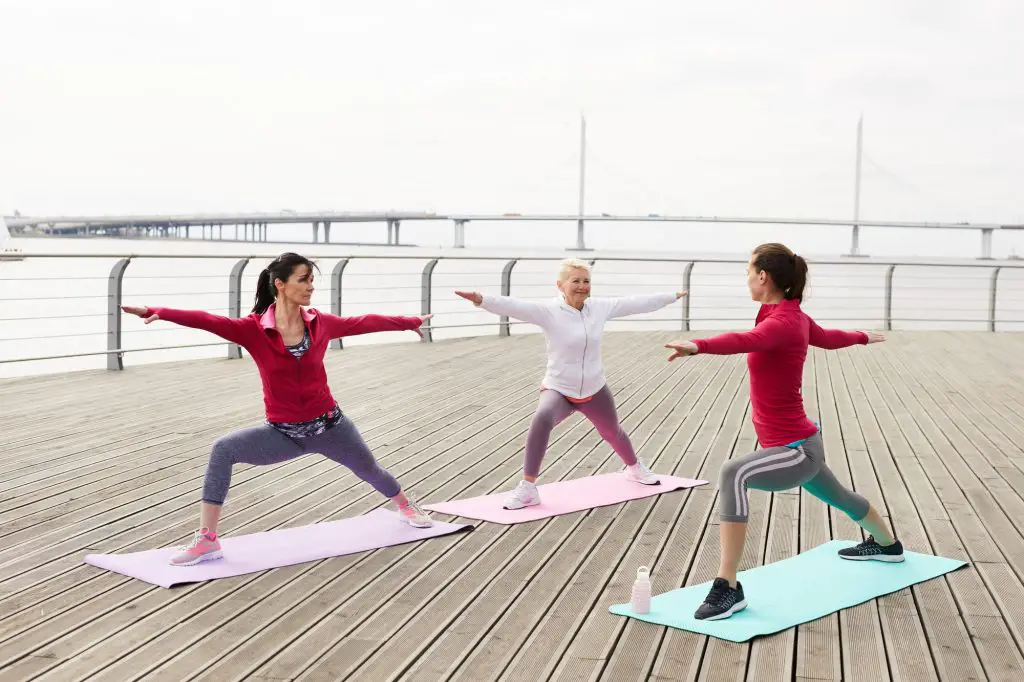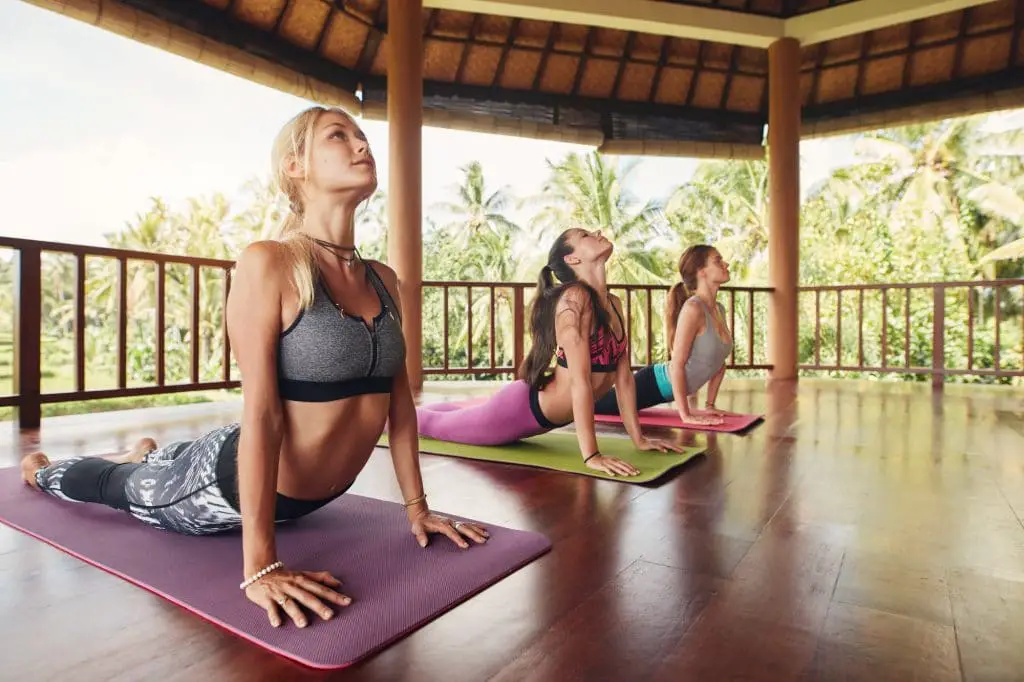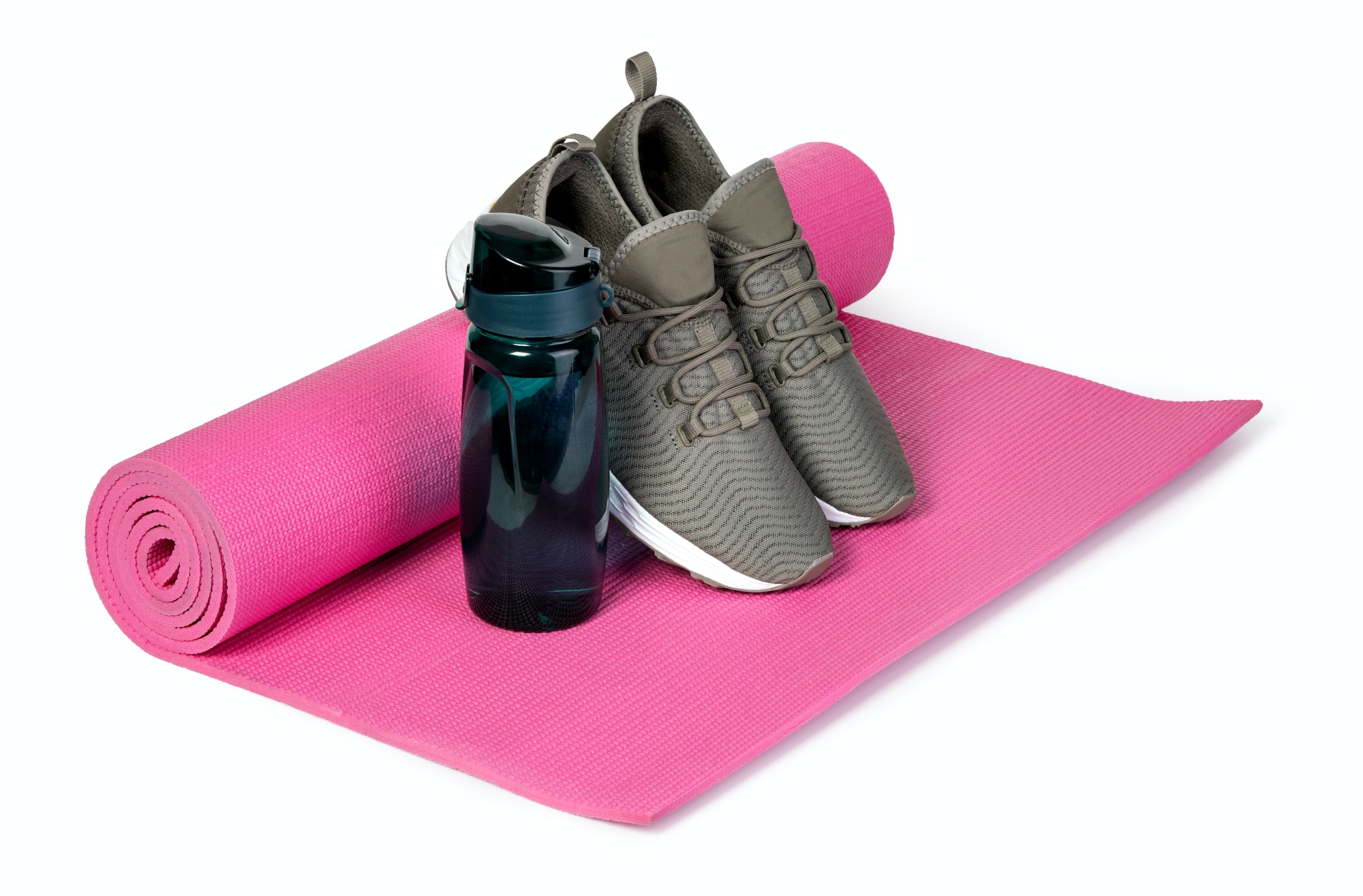There are many reasons you might be wondering if you can keep your shoes on during yoga. You might have foot issues that require support, want to ensure you get the most out of your yoga class, or are experiencing pain or discomfort when you put pressure on your bare feet.
You could have concerns about making skin contact with a loaner mat from the studio. Maybe your feet get cold, or you are just plain self-conscious about them.
You also may have noticed that everyone at your studio takes their shoes off, and you aren’t sure if you’re allowed to leave them on.
Can You Wear Shoes in Yoga?
Yes, you can wear shoes for yoga. Typically, yoga studios allow you to wear shoes in class, especially when you have preexisting medical issues or injuries. Most commonly worn shoes during a yoga class are grip socks, training shoes, and yoga shoes.
If shoes are unacceptable at your studio, there is a middle ground between shoes and bare feet that your instructor might be more open to.
However, getting a new pair of yoga shoes specifically for your yoga class is recommended, as your studio might not be too keen on you wearing shoes to your class. This might be for two main reasons:
- The outside dirt and contaminants on your shoes
- It is viewed as disrespectful to the studio
Yoga studios typically discourage the use of shoes, because they don’t want contaminants tracked into space where you are about to lay on the floor. But it can also have to do with where yoga came from.
Yoga is believed to have been practiced as far back as 5,000 years, starting in India. As with some Eastern cultures, it is considered disrespectful to wear your shoes in a home or place of worship.
Thus many current yoga studios follow this rule and consider removing shoes in the lobby as a sign of respect for the culture and studio.
Of course, modern-day yoga studios in the West are more open to making allowances. That said, If your class is firmly against shoes, you might find that socks are good middle ground.
Let’s take a look at what types of socks are available and what benefits do they offer.
| Type of Sock | Qualities That Make it Good for Yoga |
| Socks with grips on the sole | Traction |
| Socks with individual toe slots | Toe movement |
| Barre or pilates socks | Straps, traction, cushion, some have toe slots |
| Compression ballet socks | Ankle and arch support, open toes |
Related: 4 Types of Grip Sock that will Benefit You
If you would like to wear socks to your yoga class, you should probably check with your instructor to see if they have any requirements first.
If you are given free rein, some general things to look for in a yoga sock are traction and freedom of toe movement.
You will probably want to wear socks that have a grippy element on the soles, so you do not slip and slide around your mat while you’re perfecting your warrior one pose or downward dog.
A sock that allows for toe movement is important because toe dexterity and freedom of movement are essential to yoga. Socks that have individual slots for each toe might be uncomfortable for some people, so finding an open-toed sock might be a good compromise.
Another option is getting socks that were specifically made for yoga. Many yoga clothing and supply companies make socks that have grippy bottoms, straps, and/or individual slots for each toe.
What Shoes to Wear for Yoga in the Winter?

If you do wear shoes to your yoga class, something to consider is that you will probably need a pair that you put on when you get into the lobby of your studio.
Most yoga studios require that you remove your outside shoes in a waiting area, before entering the yoga room itself, so as not to track in dirt.
If you get cold feet and are worried about being uncomfortable during class in the colder months, a pair of yoga socks can be a great way to keep your toes warm without compromising the benefits of going barefoot.
If you have preexisting foot issues and need the extra support of shoes, an athletic shoe made with yoga in mind is the next best option, as it offers the most coverage and support. It will keep your foot warmer than other yoga shoes.
Do People Wear Shoes for Outdoor Yoga?
Most people wear shoes for outdoor yoga. Outdoor classes are sometimes held at public parks. Doing a yoga class at the park barefoot might make you feel a little exposed. You also won’t want to step with your dirty shoes onto your mat.
| Concern | Should I Wear Shoes? | Best Shoe Options |
| Outdoor Yoga | Only if you would feel more comfortable | Athletic yoga shoes or cross-trainers if they are clean, yoga specific shoes if they won’t leave the mat |
| Cleanliness Of Yoga Studio | Not necessarily, equipment should be disinfected between uses | Any grippy sock or shoe that covers the entire foot |
| Discomfort | No, unless you have a preexisting condition, or pain persists. | If you have persisting discomfort, a supportive shoe like an athletic yoga shoe. |
If your main concern is cleanliness, check with your studio about their communal mat disinfecting procedures. Any decent studio won’t be reusing mats without cleaning them first, but you can avoid the whole issue by purchasing and bringing your mat to class.
When you are new to yoga and working out barefoot, you might experience some discomfort at first. Eventually, any foot pain should subside as your foot gets used to the exercises, just like any other sport.
However, if the pain continues for an extended period, you should get checked out by a doctor and potentially find a supportive athletic yoga shoe.
Best Shoes for Yoga Class
If your yoga class allows shoes, or if you have a foot condition that requires extra support, shop for a pair dedicated for your class. Let’s take a look at 3 popular types that most people bring with them to the yoga studio:
| Type of Footwear | Features | Price |
| Yoga “skins” shoes Look like wraps. | Lightweight Breathable Very Thin | Cheaper |
| Athletic shoes | Good support Firm Great for the gym yoga class | More Expensive |
| Toe type shoes | Lightweight Minimalist shoes Allows toe movement | Average |
The strappy, “skin” type of yoga shoes allow for more support than going barefoot for someone with minor foot conditions, while not completely compromising their ability to connect to the ground. They are the most breathable of the three and provide grip and traction.
 VIFUUR Barefoot Yoga Socks Slip-on
VIFUUR Barefoot Yoga Socks Slip-on
VIFUUR’ slip-on yoga socks are the best sellers in Amazon for both water sports and yoga. They are super flexible and almost feel like there is no weight to them. The sole is made of very thin flexible rubber and it’s very comfortable.
It is not ideal to walk in the rough area with these socks because it does not have protection on the toe area and back of your heel, but it’s awesome for various sports as it has excellent anti-slip protection, and it’s like grip socks but fit like shoes.
HMIYA Barefoot Yoga Socks
These are super comfortable and lightweight. Think of it as thicker socks but it’s a shoe, it’s almost like you’re not wearing anything on your foot. It was designed as aqua socks but it great for yoga classes.
It has a thick anti-slip sole but it is not bulky at all. You can easily fold them like a burrito and take them with you in your gym bag. These are very popular among seasoned yoga girls who are hygiene conscious and do not want to touch the floor with their barefoot.
FitKicks Foldable Minimalist Yoga Shoes
These shoes are perfect for travel slippers, walk around the pool, and yoga classes. The good thing about these shoes is that they can be worn as casual walking shoes, where aqua “skin” shoes are not very good at walking on pavement.
They are easily washable in the washing machine and will last a long time. The only thing is it does not have good arch support. If you need arch support we recommend you trying sneakers.
Some companies have designed shoes that have the look of regular athletic shoes but were made with yoga in mind. They offer the most support and were made to be more flexible and lightweight than your average athletic shoe.
TIOSEBON Women’s Athletic Shoes
TIOSEBON women’s shoes have one of the best breathability among the athletic shoes for yoga. If you’re used to wearing shoes barefoot, these are ideal during hot weather due to their nice breathability.
If you have wide feet it is recommended to order a half size bigger. If you are size 8.5, go for size 9 and it will fit you well. It has a knit mesh fabric upper and it won’t rub against your feet so you won’t get blisters.
adidas Women’s Cloudfoam Shoes
These shoes are vegan as they are made of fabric and rubber, and don’t have animal-derived components. It fit very well with a mesh upper that’s stretchy and has an amazing step-in feel to it. It’s ideal for barefoot and perfect for outdoor yoga.
In terms of the fit, if you’re between size 8.5 and 9, it is recommended to go for 8.5. Especially if you go sockless or thin socks for your yoga class. This pair of shoes has positive feedbacks for protection from getting blisters.
Skechers Women’s Flex Appeal 3.0 Sneaker
Skechers women’s flex appeal 3.0 has a rubber sole and they are lightweight with a supportive midsole. It is not ideal for running, but it’s great for walking your dogs and casual shopping.
In comparison to Skechers Flex Appeal 2.0 it has a better pattern design, so pebbles and ground debris don’t get stuck under the shoes. However, 2.0 seems to be slightly lighter than 3.0, but not a noticeable difference. It is a great choice for casual walking and outdoor yoga class.
Shoes that have slots for each of your toes are a good middle ground between these three options. They find a balance between offering extra support and still allowing for toe movement and grounding.
WHITIN Women’s Minimalist & Barefoot Shoes
These minimalist & barefoot shoes are perfect for yoga. It is lightweight, has zero drop, and makes you balance well, and help better maintain posture during your session. As it is a minimalist toe shoe, it will wrap your feel well and give you a secure fit.
Unlike Joomra minimalist shoes, this one fits true to size. Some users report that they wear size 9.5 for athletic sneakers but they wear size 9 in other shoes. They bought WITHIN size 9 and it fitsperfectly.
Oranginer Women’s Barefoot Minimalist Shoes
These shoes have a wide toe box design, which lets your toes relax and spread out naturally. Many people who wore this shoe had feedback to comfort and it felt like grip socks instead of heavy and bulky cross trainer shoes.
It has a synthetic mesh upper which offers you breathability when you are stretching during yoga. These minimalist shoes are recommended for people who want a little bit more cushion than aqua skin shoes.
JOOMRA Women’s Minimalist Barefoot Shoes
These rubber sole minimalist shoes are great for people who do not want to wear a cushioned cross-training shoes to their yoga class. It has a tick topline that wraps your feet well, and it won’t wiggle around during your session.
The downside is that it does not have a lot of support, but that’s because it’s minimalist shoes and you’re using it in yoga, not trail running. It also fits slightly bigger so if you’re size 8.5, it is recommended to buy it at size 8.
Is Barefoot Better Than Shoes for Yoga?

If you do not have a medical reason to wear shoes to yoga, you should look at the benefits of going barefoot before you buy a yoga shoe.
- Just like cross training shoes have a thinner sole that helps you feel more grounded while you workout, going barefoot provides grounding by allowing your foot to directly connect with the floor in its most natural state.
- Bare feet provide the best balance and assist with alignment.
- Arch and toe movement is essential to yoga, and you have the most freedom of movement when your feet are bare.
If you’ve done a yoga class before, you’ve probably heard a teacher instruct you to spread your toes. With practice, it will get easier, and there are benefits to working on your toe dexterity.
Your toes are integral to your balance. Spreading your toes gives you a wider base with which to balance, and makes moves like tree pose, where you stand on one foot, easier to achieve.
Beyond class, anything you might be doing with your feet, from walking to climbing stairs, is going to be affected by your toe flexibility.
You are probably aware of how something goes wrong with one muscle or joint, the rest of your body adjusts to accommodate your injury, and how that accommodation can cause even more issues in other areas.
Similarly, never addressing the weaknesses of your toes can potentially lead to issues in other areas of your body, including Achilles heel or knee tendinitis.

Austin is the author of loveatfirstfit.com and a personal trainer with extensive knowledge in nutrition. Austin is passionate about helping others to find a suitable healthy lifestyle and feel good about themselves. Austin’s goal is to help people push their limits and achieve their physical performance.










